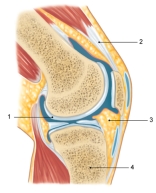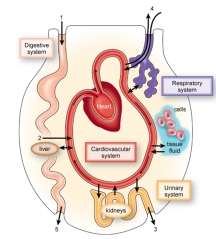A) The body temperature would continue to increase.
B) The body temperature would decrease.
C) The signal to the control center that the set point had been exceeded would stop being sent.
D) The signal from the control center to the blood vessels and sweat glands would stop being sent.
E) The blood vessels would constrict.
Correct Answer

verified
Correct Answer
verified
True/False
To enter the body, substances have to pass through connective tissue cells to reach the tissues beneath.
Correct Answer

verified
Correct Answer
verified
Multiple Choice
Environmental air temperature can fluctuate many degrees during the course of a day. A human's body temperature
A) can also fluctuate many degrees.
B) is lowered by shivering.
C) must be maintained within a range of a few degrees.
D) is not maintained internally but fluctuates with the air temperature.
E) is raised by sweating and dilation of blood vessels in the skin.
Correct Answer

verified
Correct Answer
verified
Multiple Choice
Movement of body parts directly requires the
A) muscular system and skeletal system.
B) nervous system and endocrine system.
C) skeletal system and digestive system.
D) muscular system and cardiovascular system.
E) endocrine system and nervous system.
Correct Answer

verified
Correct Answer
verified
Multiple Choice
Figure:  Using the figure shown here as a guide, answer the following questions about the situation described.
Jane dives into a swimming pool to retrieve a diving ring from the bottom, holding her breath the whole time she is underwater. This act causes an increase in the concentration of carbon dioxide in her blood. As she surfaces, chemoreceptors in certain major arteries detect the change from normal. These receptors cause impulses to be sent to the medulla oblongata. The medulla oblongata sends impulses to the diaphragm and muscles between the ribs causing more frequent and more forceful inhalations and exhalations. This in turn causes a decrease in the concentration of carbon dioxide in the blood.
-The stimulus in this scenario is
Using the figure shown here as a guide, answer the following questions about the situation described.
Jane dives into a swimming pool to retrieve a diving ring from the bottom, holding her breath the whole time she is underwater. This act causes an increase in the concentration of carbon dioxide in her blood. As she surfaces, chemoreceptors in certain major arteries detect the change from normal. These receptors cause impulses to be sent to the medulla oblongata. The medulla oblongata sends impulses to the diaphragm and muscles between the ribs causing more frequent and more forceful inhalations and exhalations. This in turn causes a decrease in the concentration of carbon dioxide in the blood.
-The stimulus in this scenario is
A) the increase in carbon dioxide concentration in Jane's blood while she is holding her breath.
B) the impulses sent to the medulla oblongata.
C) the more frequent inhalations and exhalations.
D) the decrease in carbon dioxide concentration as she breathes more forcefully.
E) Jane diving into the swimming pool.
Correct Answer

verified
Correct Answer
verified
Multiple Choice
Figure:  -In the figure shown here, the tissue indicated by "3"
-In the figure shown here, the tissue indicated by "3"
A) lends strength to and supports the joint.
B) cushions the bones of the joint.
C) attaches muscle to the bones.
D) provides a smooth surface on the ends of bones.
E) causes the movement of the joint.
Correct Answer

verified
Correct Answer
verified
Multiple Choice
Which of the following is NOT a characteristic of connective tissue?
A) secretion and absorption
B) protection
C) cushioning and insulation
D) supporting
E) storage
Correct Answer

verified
Correct Answer
verified
Multiple Choice
The nervous system and endocrine system control the body's functions by
A) maintaining a constant level of nerve impulses.
B) sending out messages by nerve impulse and hormones.
C) responding only to the internal environment.
D) stimulating the body's reproductive organs.
E) maintaining a constant level of hormones in the blood.
Correct Answer

verified
Correct Answer
verified
Multiple Choice
The ___________ system is the only system in which there are different organs in males and females.
A) reproductive
B) integumentary
C) muscular
D) cardiovascular
E) digestive
Correct Answer

verified
Correct Answer
verified
Multiple Choice
What is the distinctive characteristic of connective tissue?
A) flat, interconnected cells
B) presence of a matrix
C) presence of axons
D) contractile ability
E) being hard and mineralized
Correct Answer

verified
Correct Answer
verified
Multiple Choice
Which of the following lists the levels of biological organization in order from simplest to most complex?
A) cell, cardiac muscle, heart, cardiovascular system, human
B) cardiac muscle, cell, human, heart, cardiovascular system
C) human, heart, cardiovascular system, cardiac muscle, cell
D) cell, heart, human, cardiovascular system, cardiac muscle
E) heart, human, cell, cardiac muscle, cardiovascular system
Correct Answer

verified
Correct Answer
verified
Multiple Choice
Which body system and its organs are INCORRECTLY matched?
A) digestive - mouth, stomach, intestines
B) lymphatic - thymus, vessels, nodes
C) endocrine - mouth, lungs, pituitary
D) reproductive - ovaries, testes, uterus
E) cardiovascular - heart, blood, blood vessels
Correct Answer

verified
Correct Answer
verified
True/False
The urinary system and respiratory system both participate in homeostasis by removing metabolic waste.
Correct Answer

verified
Correct Answer
verified
Multiple Choice
Which of the following is NOT true of a negative-feedback mechanism?
A) The change from the set point is made smaller.
B) Most control mechanisms in the body are of this type.
C) The deviation from normal is made larger.
D) Blood pressure maintenance is an example of negative-feedback.
E) They are important for maintenance of homeostasis.
Correct Answer

verified
Correct Answer
verified
Multiple Choice
Skeletal muscle and cardiac muscle are similar in that they are both
A) under voluntary control.
B) under involuntary control.
C) made of highly branched cells.
D) striated.
E) made of long parallel cells.
Correct Answer

verified
Correct Answer
verified
Multiple Choice
Which of the following lists types of connective tissue from least rigid to most rigid?
A) hyaline cartilage - loose fibrous - bone - blood
B) blood - loose fibrous - hyaline cartilage - bone
C) loose fibrous - blood - bone - hyaline cartilage
D) bone - hyaline cartilage - blood - loose fibrous
E) blood - bone - hyaline cartilage - loose fibrous
Correct Answer

verified
Correct Answer
verified
Multiple Choice
The liver is epithelial in origin as shown by what characteristic?
A) its ability to regenerate
B) the matrix formed outside the cells
C) the fibrous tissue which stores glycogen
D) its ability to stretch
E) its ability to generate electrical impulses
Correct Answer

verified
Correct Answer
verified
Multiple Choice
Figure:  -In the figure shown here, _________ moves into the body and _________ moves out of the body through the respiratory system at "4."
-In the figure shown here, _________ moves into the body and _________ moves out of the body through the respiratory system at "4."
A) nutrients; metabolic wastes
B) wastes; nutrients
C) carbon dioxide; oxygen
D) oxygen; carbon dioxide
E) water; urine
Correct Answer

verified
Correct Answer
verified
Multiple Choice
Which body system produces red blood cells?
A) cardiovascular
B) lymphatic
C) skeletal
D) muscular
E) endocrine
Correct Answer

verified
Correct Answer
verified
Multiple Choice
Within a negative feedback loop,
A) the effect causes a response.
B) the sensor sends data to the control center.
C) the control center detects a change in the internal environment.
D) the sensor causes an effect to return conditions to normal.
E) the stimulus sends data to the control center.
Correct Answer

verified
Correct Answer
verified
Showing 21 - 40 of 56
Related Exams